Cloud Computing and IoT Integration: Industry Trends and Challenges
VerifiedAdded on 2023/03/23
|21
|6299
|94
Report
AI Summary
This report provides a comprehensive analysis of the integration between Cloud Computing and the Internet of Things (IoT). It begins with an introduction to both technologies and their fundamental characteristics. The discussion section includes summaries of four peer-reviewed articles focusing on CloudIoT platforms, challenges in privacy, security, performance, and reliability, and solutions involving enhanced security measures and strategic information sharing. The report further explores challenges such as lack of trust, data integrity, delivering value to customers, and hardware compatibility issues. It also discusses future work in areas like enhanced security, real-time data processing, and improved interoperability. Current industry trends in healthcare, smart homes/cities, automotive, and smart energy are examined, followed by a business case study illustrating the practical application of Cloud-IoT integration. The report concludes by emphasizing the significant advantages and potential of this integration while acknowledging the need to address existing challenges for successful implementation.
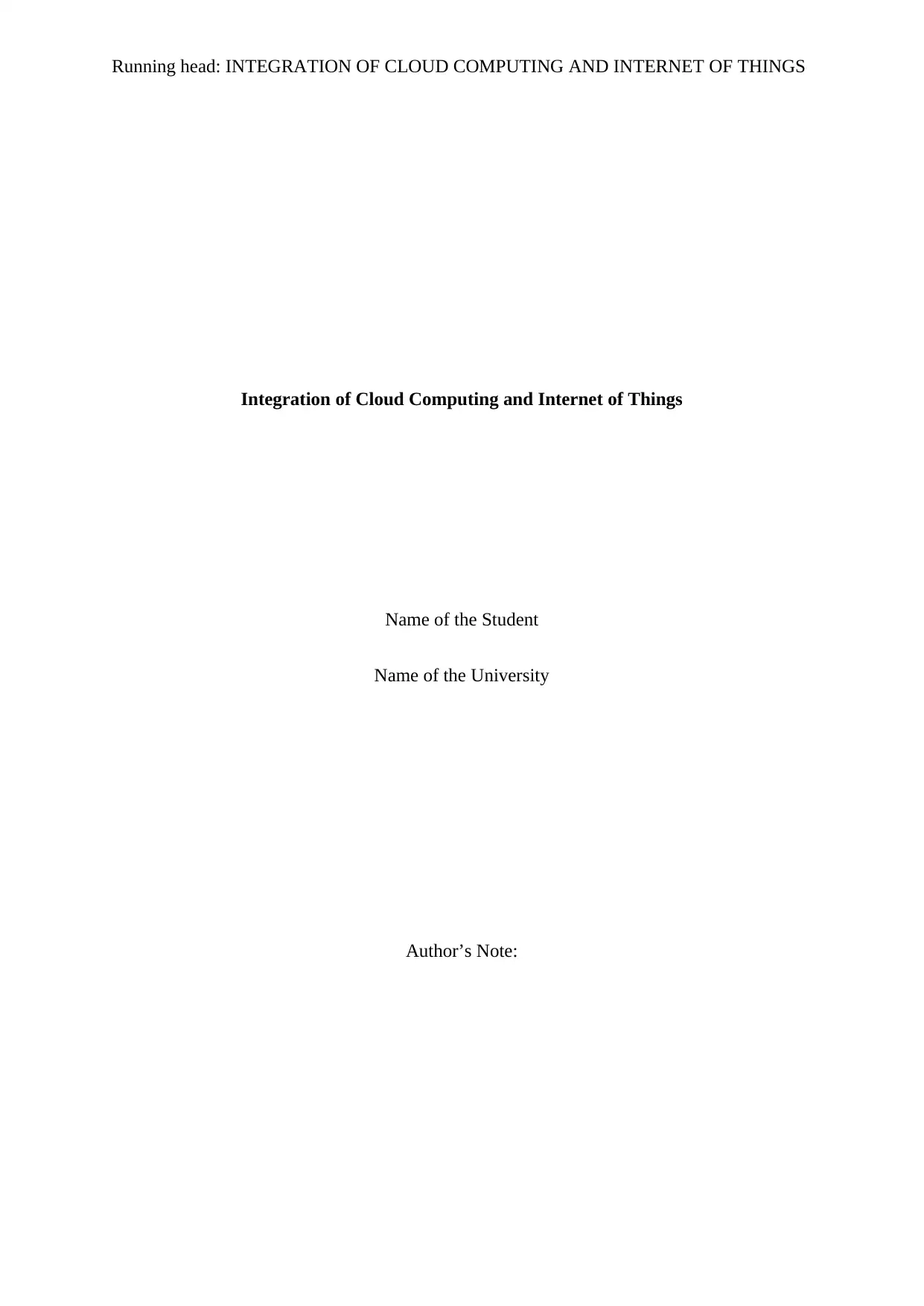
Running head: INTEGRATION OF CLOUD COMPUTING AND INTERNET OF THINGS
Integration of Cloud Computing and Internet of Things
Name of the Student
Name of the University
Author’s Note:
Integration of Cloud Computing and Internet of Things
Name of the Student
Name of the University
Author’s Note:
Paraphrase This Document
Need a fresh take? Get an instant paraphrase of this document with our AI Paraphraser
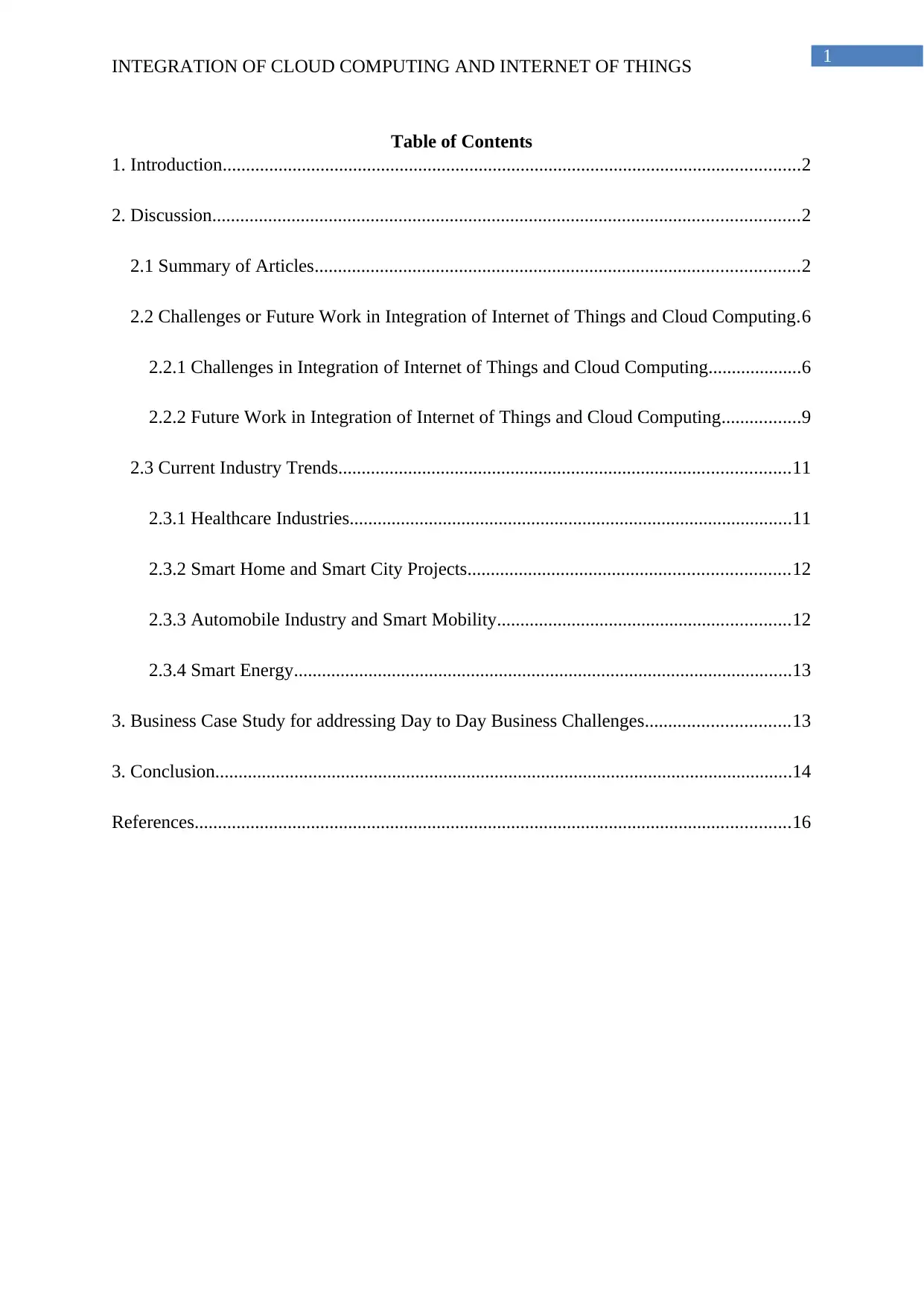
1
INTEGRATION OF CLOUD COMPUTING AND INTERNET OF THINGS
Table of Contents
1. Introduction............................................................................................................................2
2. Discussion..............................................................................................................................2
2.1 Summary of Articles........................................................................................................2
2.2 Challenges or Future Work in Integration of Internet of Things and Cloud Computing.6
2.2.1 Challenges in Integration of Internet of Things and Cloud Computing....................6
2.2.2 Future Work in Integration of Internet of Things and Cloud Computing.................9
2.3 Current Industry Trends.................................................................................................11
2.3.1 Healthcare Industries...............................................................................................11
2.3.2 Smart Home and Smart City Projects.....................................................................12
2.3.3 Automobile Industry and Smart Mobility...............................................................12
2.3.4 Smart Energy...........................................................................................................13
3. Business Case Study for addressing Day to Day Business Challenges...............................13
3. Conclusion............................................................................................................................14
References................................................................................................................................16
INTEGRATION OF CLOUD COMPUTING AND INTERNET OF THINGS
Table of Contents
1. Introduction............................................................................................................................2
2. Discussion..............................................................................................................................2
2.1 Summary of Articles........................................................................................................2
2.2 Challenges or Future Work in Integration of Internet of Things and Cloud Computing.6
2.2.1 Challenges in Integration of Internet of Things and Cloud Computing....................6
2.2.2 Future Work in Integration of Internet of Things and Cloud Computing.................9
2.3 Current Industry Trends.................................................................................................11
2.3.1 Healthcare Industries...............................................................................................11
2.3.2 Smart Home and Smart City Projects.....................................................................12
2.3.3 Automobile Industry and Smart Mobility...............................................................12
2.3.4 Smart Energy...........................................................................................................13
3. Business Case Study for addressing Day to Day Business Challenges...............................13
3. Conclusion............................................................................................................................14
References................................................................................................................................16
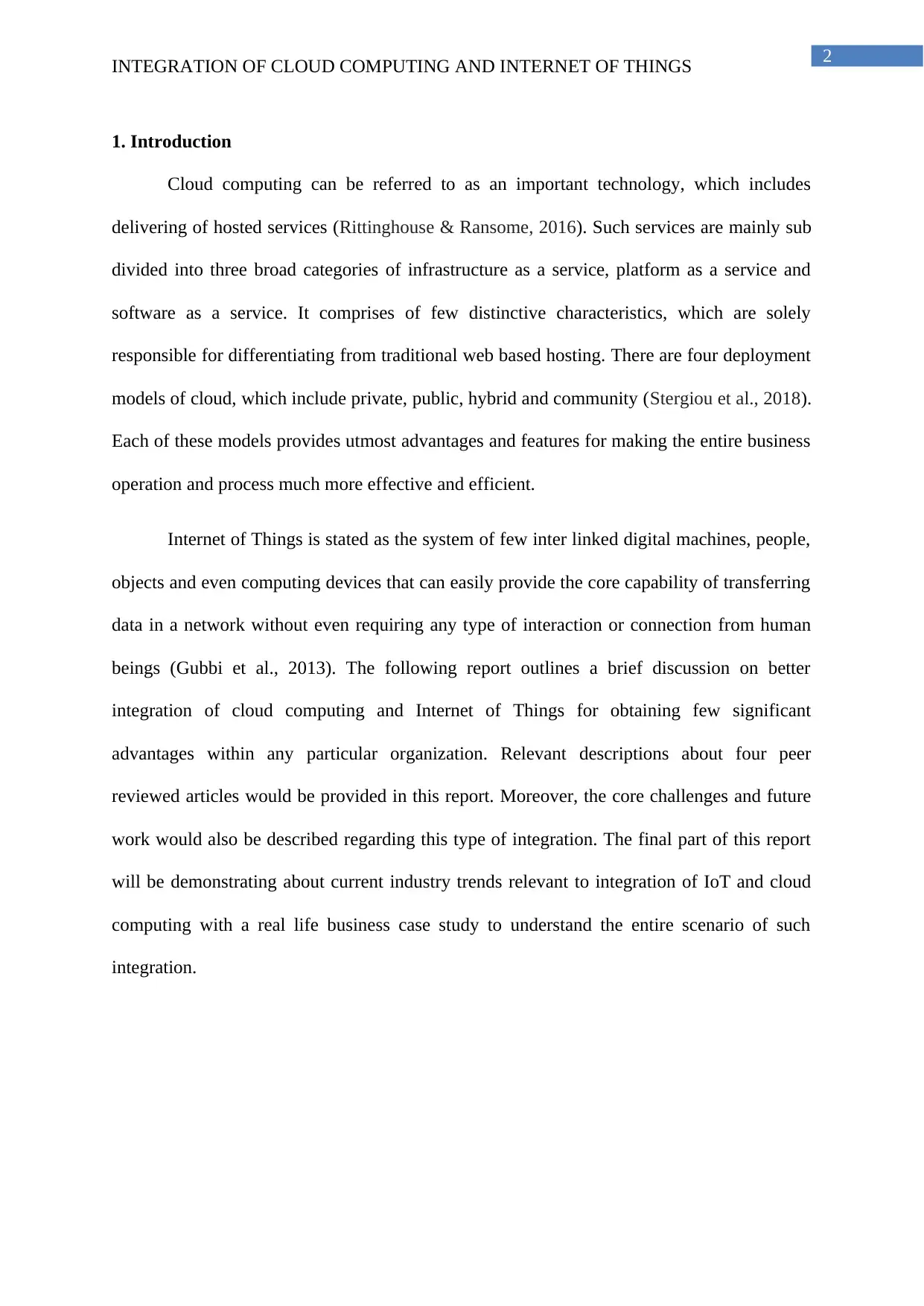
2
INTEGRATION OF CLOUD COMPUTING AND INTERNET OF THINGS
1. Introduction
Cloud computing can be referred to as an important technology, which includes
delivering of hosted services (Rittinghouse & Ransome, 2016). Such services are mainly sub
divided into three broad categories of infrastructure as a service, platform as a service and
software as a service. It comprises of few distinctive characteristics, which are solely
responsible for differentiating from traditional web based hosting. There are four deployment
models of cloud, which include private, public, hybrid and community (Stergiou et al., 2018).
Each of these models provides utmost advantages and features for making the entire business
operation and process much more effective and efficient.
Internet of Things is stated as the system of few inter linked digital machines, people,
objects and even computing devices that can easily provide the core capability of transferring
data in a network without even requiring any type of interaction or connection from human
beings (Gubbi et al., 2013). The following report outlines a brief discussion on better
integration of cloud computing and Internet of Things for obtaining few significant
advantages within any particular organization. Relevant descriptions about four peer
reviewed articles would be provided in this report. Moreover, the core challenges and future
work would also be described regarding this type of integration. The final part of this report
will be demonstrating about current industry trends relevant to integration of IoT and cloud
computing with a real life business case study to understand the entire scenario of such
integration.
INTEGRATION OF CLOUD COMPUTING AND INTERNET OF THINGS
1. Introduction
Cloud computing can be referred to as an important technology, which includes
delivering of hosted services (Rittinghouse & Ransome, 2016). Such services are mainly sub
divided into three broad categories of infrastructure as a service, platform as a service and
software as a service. It comprises of few distinctive characteristics, which are solely
responsible for differentiating from traditional web based hosting. There are four deployment
models of cloud, which include private, public, hybrid and community (Stergiou et al., 2018).
Each of these models provides utmost advantages and features for making the entire business
operation and process much more effective and efficient.
Internet of Things is stated as the system of few inter linked digital machines, people,
objects and even computing devices that can easily provide the core capability of transferring
data in a network without even requiring any type of interaction or connection from human
beings (Gubbi et al., 2013). The following report outlines a brief discussion on better
integration of cloud computing and Internet of Things for obtaining few significant
advantages within any particular organization. Relevant descriptions about four peer
reviewed articles would be provided in this report. Moreover, the core challenges and future
work would also be described regarding this type of integration. The final part of this report
will be demonstrating about current industry trends relevant to integration of IoT and cloud
computing with a real life business case study to understand the entire scenario of such
integration.
⊘ This is a preview!⊘
Do you want full access?
Subscribe today to unlock all pages.

Trusted by 1+ million students worldwide
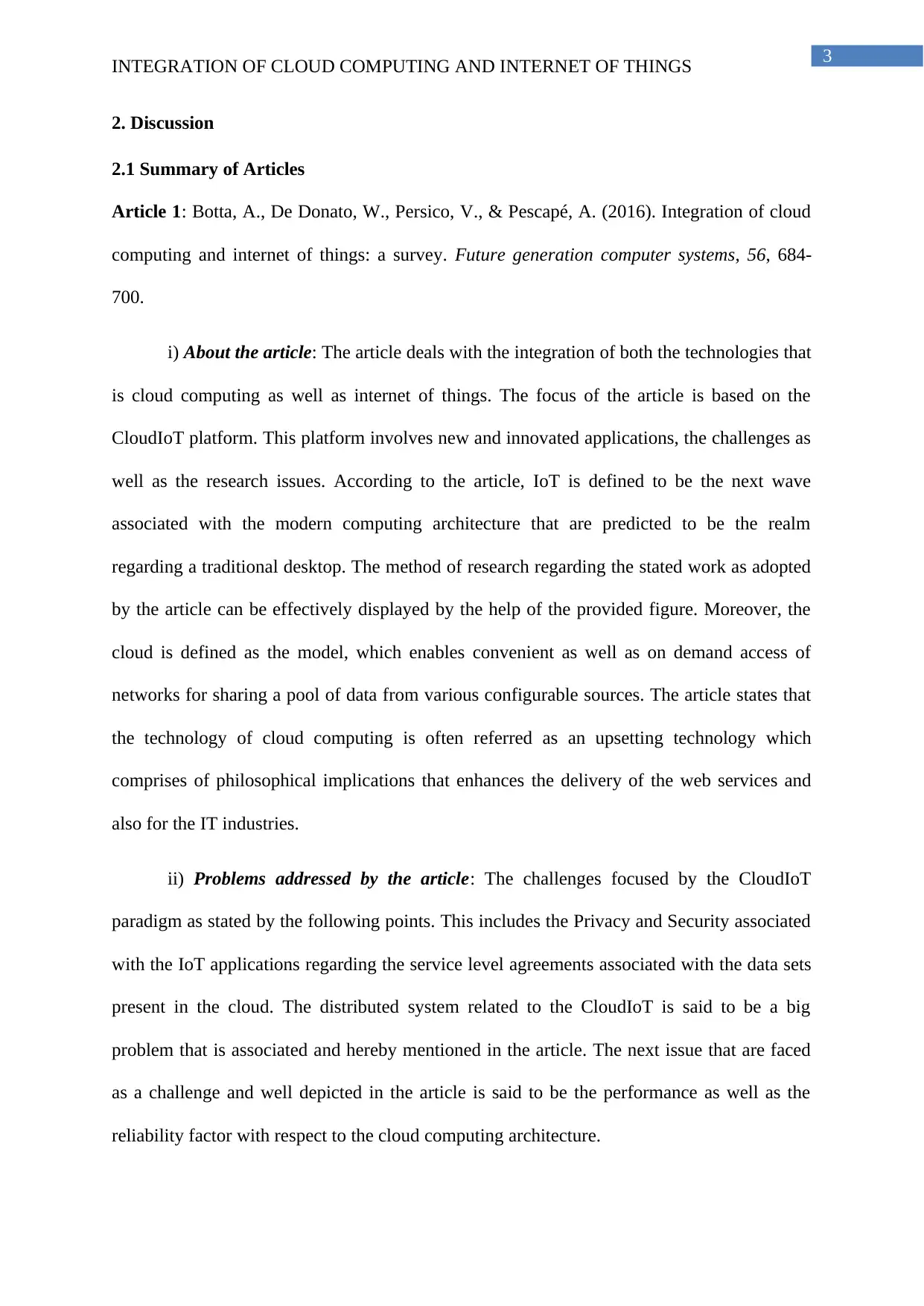
3
INTEGRATION OF CLOUD COMPUTING AND INTERNET OF THINGS
2. Discussion
2.1 Summary of Articles
Article 1: Botta, A., De Donato, W., Persico, V., & Pescapé, A. (2016). Integration of cloud
computing and internet of things: a survey. Future generation computer systems, 56, 684-
700.
i) About the article: The article deals with the integration of both the technologies that
is cloud computing as well as internet of things. The focus of the article is based on the
CloudIoT platform. This platform involves new and innovated applications, the challenges as
well as the research issues. According to the article, IoT is defined to be the next wave
associated with the modern computing architecture that are predicted to be the realm
regarding a traditional desktop. The method of research regarding the stated work as adopted
by the article can be effectively displayed by the help of the provided figure. Moreover, the
cloud is defined as the model, which enables convenient as well as on demand access of
networks for sharing a pool of data from various configurable sources. The article states that
the technology of cloud computing is often referred as an upsetting technology which
comprises of philosophical implications that enhances the delivery of the web services and
also for the IT industries.
ii) Problems addressed by the article: The challenges focused by the CloudIoT
paradigm as stated by the following points. This includes the Privacy and Security associated
with the IoT applications regarding the service level agreements associated with the data sets
present in the cloud. The distributed system related to the CloudIoT is said to be a big
problem that is associated and hereby mentioned in the article. The next issue that are faced
as a challenge and well depicted in the article is said to be the performance as well as the
reliability factor with respect to the cloud computing architecture.
INTEGRATION OF CLOUD COMPUTING AND INTERNET OF THINGS
2. Discussion
2.1 Summary of Articles
Article 1: Botta, A., De Donato, W., Persico, V., & Pescapé, A. (2016). Integration of cloud
computing and internet of things: a survey. Future generation computer systems, 56, 684-
700.
i) About the article: The article deals with the integration of both the technologies that
is cloud computing as well as internet of things. The focus of the article is based on the
CloudIoT platform. This platform involves new and innovated applications, the challenges as
well as the research issues. According to the article, IoT is defined to be the next wave
associated with the modern computing architecture that are predicted to be the realm
regarding a traditional desktop. The method of research regarding the stated work as adopted
by the article can be effectively displayed by the help of the provided figure. Moreover, the
cloud is defined as the model, which enables convenient as well as on demand access of
networks for sharing a pool of data from various configurable sources. The article states that
the technology of cloud computing is often referred as an upsetting technology which
comprises of philosophical implications that enhances the delivery of the web services and
also for the IT industries.
ii) Problems addressed by the article: The challenges focused by the CloudIoT
paradigm as stated by the following points. This includes the Privacy and Security associated
with the IoT applications regarding the service level agreements associated with the data sets
present in the cloud. The distributed system related to the CloudIoT is said to be a big
problem that is associated and hereby mentioned in the article. The next issue that are faced
as a challenge and well depicted in the article is said to be the performance as well as the
reliability factor with respect to the cloud computing architecture.
Paraphrase This Document
Need a fresh take? Get an instant paraphrase of this document with our AI Paraphraser

4
INTEGRATION OF CLOUD COMPUTING AND INTERNET OF THINGS
iii) Solutions to the problems: The article clearly depicts that the CloudIoT structure
must be enhanced in such a manner that the reliability factor and the Security measures are to
be well adapted which are clearly stated in the article.
Article 2: Cavalcante, E., Pereira, J., Alves, M. P., Maia, P., Moura, R., Batista, T., ... &
Pires, P. F. (2016). On the interplay of Internet of Things and Cloud Computing: A
systematic mapping study. Computer Communications, 89, 17-33.
i) About the article: According to the article the alignment between the technologies
of IoT as well as cloud computing may take place via the two different methodologies. This
are mainly identified as the points of bringing cloud to the things as well as bringing the
things to the clouds. The first methodology enhances the advantage regarding the
technological constraints available at the sector of IoT. On the other hand, the second
methodology enhances the leveraging capabilities of the IoT things as well as offering them
to use the services of the cloud. This relies a flexible commotion regarding the integration of
the device that happens to be used for virtualizing sharing as well as reusing the sense
devices. The article moreover provides a comprehensive overview regarding the art state of
the both topics.
ii) Problems addressed by the article: The problems that are addressed regarding this
article is that the article aims to establish a synergic relationship between the above stated
topics. Moreover the issues that the article addresses in regards to the electronic database as
well as the update of the contents that may critically assessed regarding the topics of the IoT
as well as cloud computing.
iii) Solutions to the problems: To maintain this synergic relationship the combination
of the IoT devices with the cloud technology is to be carried out effectively so that the
INTEGRATION OF CLOUD COMPUTING AND INTERNET OF THINGS
iii) Solutions to the problems: The article clearly depicts that the CloudIoT structure
must be enhanced in such a manner that the reliability factor and the Security measures are to
be well adapted which are clearly stated in the article.
Article 2: Cavalcante, E., Pereira, J., Alves, M. P., Maia, P., Moura, R., Batista, T., ... &
Pires, P. F. (2016). On the interplay of Internet of Things and Cloud Computing: A
systematic mapping study. Computer Communications, 89, 17-33.
i) About the article: According to the article the alignment between the technologies
of IoT as well as cloud computing may take place via the two different methodologies. This
are mainly identified as the points of bringing cloud to the things as well as bringing the
things to the clouds. The first methodology enhances the advantage regarding the
technological constraints available at the sector of IoT. On the other hand, the second
methodology enhances the leveraging capabilities of the IoT things as well as offering them
to use the services of the cloud. This relies a flexible commotion regarding the integration of
the device that happens to be used for virtualizing sharing as well as reusing the sense
devices. The article moreover provides a comprehensive overview regarding the art state of
the both topics.
ii) Problems addressed by the article: The problems that are addressed regarding this
article is that the article aims to establish a synergic relationship between the above stated
topics. Moreover the issues that the article addresses in regards to the electronic database as
well as the update of the contents that may critically assessed regarding the topics of the IoT
as well as cloud computing.
iii) Solutions to the problems: To maintain this synergic relationship the combination
of the IoT devices with the cloud technology is to be carried out effectively so that the
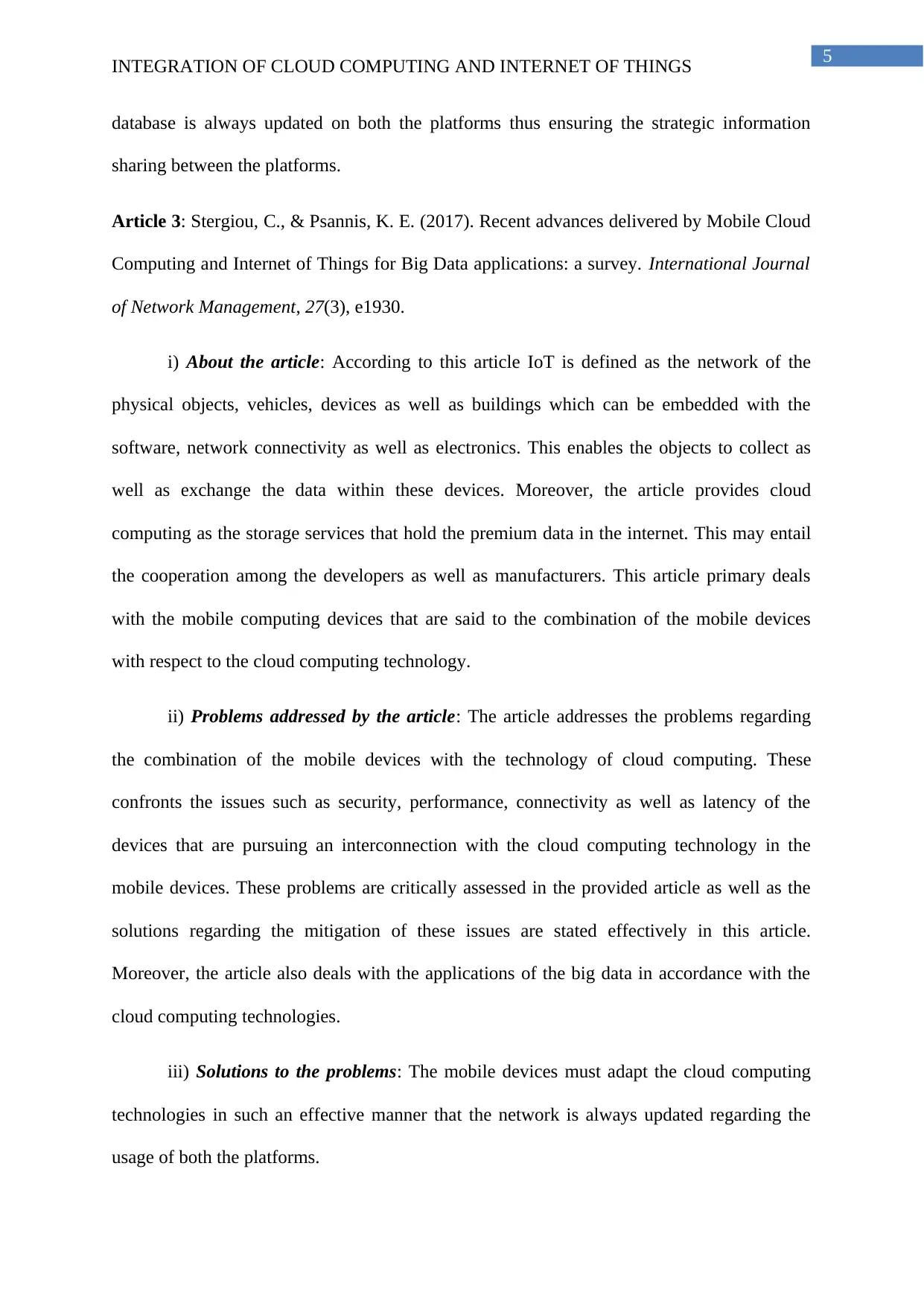
5
INTEGRATION OF CLOUD COMPUTING AND INTERNET OF THINGS
database is always updated on both the platforms thus ensuring the strategic information
sharing between the platforms.
Article 3: Stergiou, C., & Psannis, K. E. (2017). Recent advances delivered by Mobile Cloud
Computing and Internet of Things for Big Data applications: a survey. International Journal
of Network Management, 27(3), e1930.
i) About the article: According to this article IoT is defined as the network of the
physical objects, vehicles, devices as well as buildings which can be embedded with the
software, network connectivity as well as electronics. This enables the objects to collect as
well as exchange the data within these devices. Moreover, the article provides cloud
computing as the storage services that hold the premium data in the internet. This may entail
the cooperation among the developers as well as manufacturers. This article primary deals
with the mobile computing devices that are said to the combination of the mobile devices
with respect to the cloud computing technology.
ii) Problems addressed by the article: The article addresses the problems regarding
the combination of the mobile devices with the technology of cloud computing. These
confronts the issues such as security, performance, connectivity as well as latency of the
devices that are pursuing an interconnection with the cloud computing technology in the
mobile devices. These problems are critically assessed in the provided article as well as the
solutions regarding the mitigation of these issues are stated effectively in this article.
Moreover, the article also deals with the applications of the big data in accordance with the
cloud computing technologies.
iii) Solutions to the problems: The mobile devices must adapt the cloud computing
technologies in such an effective manner that the network is always updated regarding the
usage of both the platforms.
INTEGRATION OF CLOUD COMPUTING AND INTERNET OF THINGS
database is always updated on both the platforms thus ensuring the strategic information
sharing between the platforms.
Article 3: Stergiou, C., & Psannis, K. E. (2017). Recent advances delivered by Mobile Cloud
Computing and Internet of Things for Big Data applications: a survey. International Journal
of Network Management, 27(3), e1930.
i) About the article: According to this article IoT is defined as the network of the
physical objects, vehicles, devices as well as buildings which can be embedded with the
software, network connectivity as well as electronics. This enables the objects to collect as
well as exchange the data within these devices. Moreover, the article provides cloud
computing as the storage services that hold the premium data in the internet. This may entail
the cooperation among the developers as well as manufacturers. This article primary deals
with the mobile computing devices that are said to the combination of the mobile devices
with respect to the cloud computing technology.
ii) Problems addressed by the article: The article addresses the problems regarding
the combination of the mobile devices with the technology of cloud computing. These
confronts the issues such as security, performance, connectivity as well as latency of the
devices that are pursuing an interconnection with the cloud computing technology in the
mobile devices. These problems are critically assessed in the provided article as well as the
solutions regarding the mitigation of these issues are stated effectively in this article.
Moreover, the article also deals with the applications of the big data in accordance with the
cloud computing technologies.
iii) Solutions to the problems: The mobile devices must adapt the cloud computing
technologies in such an effective manner that the network is always updated regarding the
usage of both the platforms.
⊘ This is a preview!⊘
Do you want full access?
Subscribe today to unlock all pages.

Trusted by 1+ million students worldwide
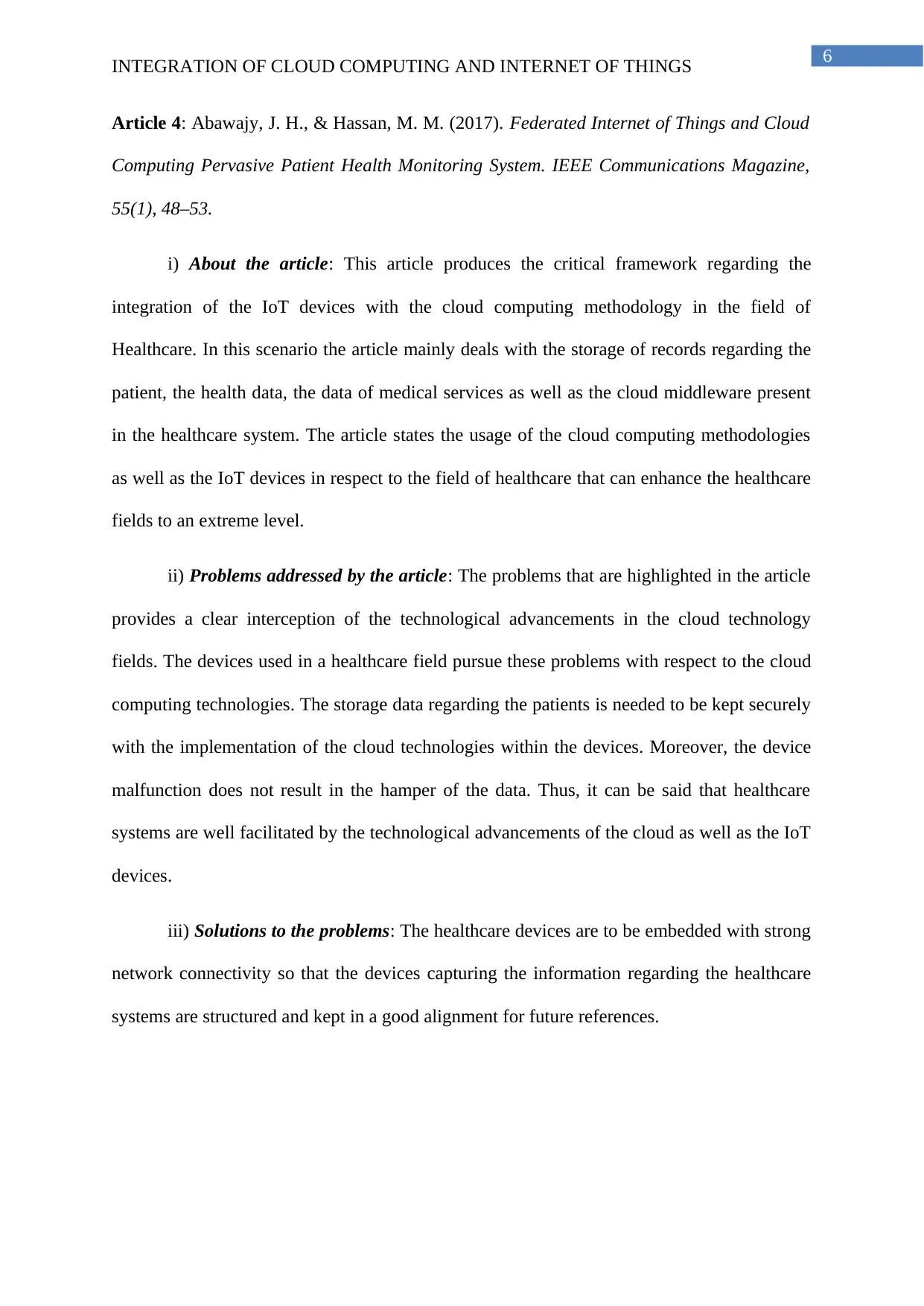
6
INTEGRATION OF CLOUD COMPUTING AND INTERNET OF THINGS
Article 4: Abawajy, J. H., & Hassan, M. M. (2017). Federated Internet of Things and Cloud
Computing Pervasive Patient Health Monitoring System. IEEE Communications Magazine,
55(1), 48–53.
i) About the article: This article produces the critical framework regarding the
integration of the IoT devices with the cloud computing methodology in the field of
Healthcare. In this scenario the article mainly deals with the storage of records regarding the
patient, the health data, the data of medical services as well as the cloud middleware present
in the healthcare system. The article states the usage of the cloud computing methodologies
as well as the IoT devices in respect to the field of healthcare that can enhance the healthcare
fields to an extreme level.
ii) Problems addressed by the article: The problems that are highlighted in the article
provides a clear interception of the technological advancements in the cloud technology
fields. The devices used in a healthcare field pursue these problems with respect to the cloud
computing technologies. The storage data regarding the patients is needed to be kept securely
with the implementation of the cloud technologies within the devices. Moreover, the device
malfunction does not result in the hamper of the data. Thus, it can be said that healthcare
systems are well facilitated by the technological advancements of the cloud as well as the IoT
devices.
iii) Solutions to the problems: The healthcare devices are to be embedded with strong
network connectivity so that the devices capturing the information regarding the healthcare
systems are structured and kept in a good alignment for future references.
INTEGRATION OF CLOUD COMPUTING AND INTERNET OF THINGS
Article 4: Abawajy, J. H., & Hassan, M. M. (2017). Federated Internet of Things and Cloud
Computing Pervasive Patient Health Monitoring System. IEEE Communications Magazine,
55(1), 48–53.
i) About the article: This article produces the critical framework regarding the
integration of the IoT devices with the cloud computing methodology in the field of
Healthcare. In this scenario the article mainly deals with the storage of records regarding the
patient, the health data, the data of medical services as well as the cloud middleware present
in the healthcare system. The article states the usage of the cloud computing methodologies
as well as the IoT devices in respect to the field of healthcare that can enhance the healthcare
fields to an extreme level.
ii) Problems addressed by the article: The problems that are highlighted in the article
provides a clear interception of the technological advancements in the cloud technology
fields. The devices used in a healthcare field pursue these problems with respect to the cloud
computing technologies. The storage data regarding the patients is needed to be kept securely
with the implementation of the cloud technologies within the devices. Moreover, the device
malfunction does not result in the hamper of the data. Thus, it can be said that healthcare
systems are well facilitated by the technological advancements of the cloud as well as the IoT
devices.
iii) Solutions to the problems: The healthcare devices are to be embedded with strong
network connectivity so that the devices capturing the information regarding the healthcare
systems are structured and kept in a good alignment for future references.
Paraphrase This Document
Need a fresh take? Get an instant paraphrase of this document with our AI Paraphraser
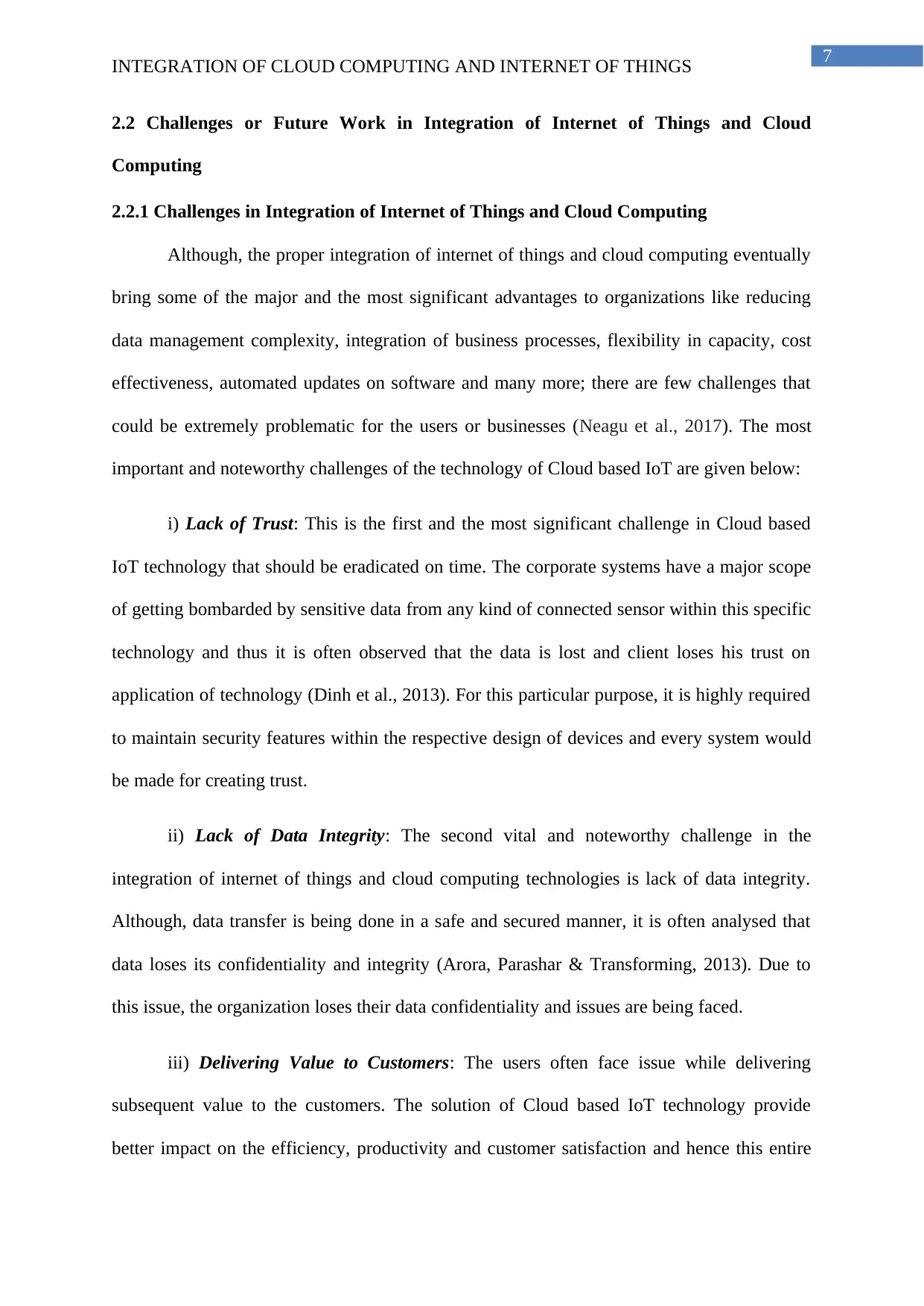
7
INTEGRATION OF CLOUD COMPUTING AND INTERNET OF THINGS
2.2 Challenges or Future Work in Integration of Internet of Things and Cloud
Computing
2.2.1 Challenges in Integration of Internet of Things and Cloud Computing
Although, the proper integration of internet of things and cloud computing eventually
bring some of the major and the most significant advantages to organizations like reducing
data management complexity, integration of business processes, flexibility in capacity, cost
effectiveness, automated updates on software and many more; there are few challenges that
could be extremely problematic for the users or businesses (Neagu et al., 2017). The most
important and noteworthy challenges of the technology of Cloud based IoT are given below:
i) Lack of Trust: This is the first and the most significant challenge in Cloud based
IoT technology that should be eradicated on time. The corporate systems have a major scope
of getting bombarded by sensitive data from any kind of connected sensor within this specific
technology and thus it is often observed that the data is lost and client loses his trust on
application of technology (Dinh et al., 2013). For this particular purpose, it is highly required
to maintain security features within the respective design of devices and every system would
be made for creating trust.
ii) Lack of Data Integrity: The second vital and noteworthy challenge in the
integration of internet of things and cloud computing technologies is lack of data integrity.
Although, data transfer is being done in a safe and secured manner, it is often analysed that
data loses its confidentiality and integrity (Arora, Parashar & Transforming, 2013). Due to
this issue, the organization loses their data confidentiality and issues are being faced.
iii) Delivering Value to Customers: The users often face issue while delivering
subsequent value to the customers. The solution of Cloud based IoT technology provide
better impact on the efficiency, productivity and customer satisfaction and hence this entire
INTEGRATION OF CLOUD COMPUTING AND INTERNET OF THINGS
2.2 Challenges or Future Work in Integration of Internet of Things and Cloud
Computing
2.2.1 Challenges in Integration of Internet of Things and Cloud Computing
Although, the proper integration of internet of things and cloud computing eventually
bring some of the major and the most significant advantages to organizations like reducing
data management complexity, integration of business processes, flexibility in capacity, cost
effectiveness, automated updates on software and many more; there are few challenges that
could be extremely problematic for the users or businesses (Neagu et al., 2017). The most
important and noteworthy challenges of the technology of Cloud based IoT are given below:
i) Lack of Trust: This is the first and the most significant challenge in Cloud based
IoT technology that should be eradicated on time. The corporate systems have a major scope
of getting bombarded by sensitive data from any kind of connected sensor within this specific
technology and thus it is often observed that the data is lost and client loses his trust on
application of technology (Dinh et al., 2013). For this particular purpose, it is highly required
to maintain security features within the respective design of devices and every system would
be made for creating trust.
ii) Lack of Data Integrity: The second vital and noteworthy challenge in the
integration of internet of things and cloud computing technologies is lack of data integrity.
Although, data transfer is being done in a safe and secured manner, it is often analysed that
data loses its confidentiality and integrity (Arora, Parashar & Transforming, 2013). Due to
this issue, the organization loses their data confidentiality and issues are being faced.
iii) Delivering Value to Customers: The users often face issue while delivering
subsequent value to the customers. The solution of Cloud based IoT technology provide
better impact on the efficiency, productivity and customer satisfaction and hence this entire
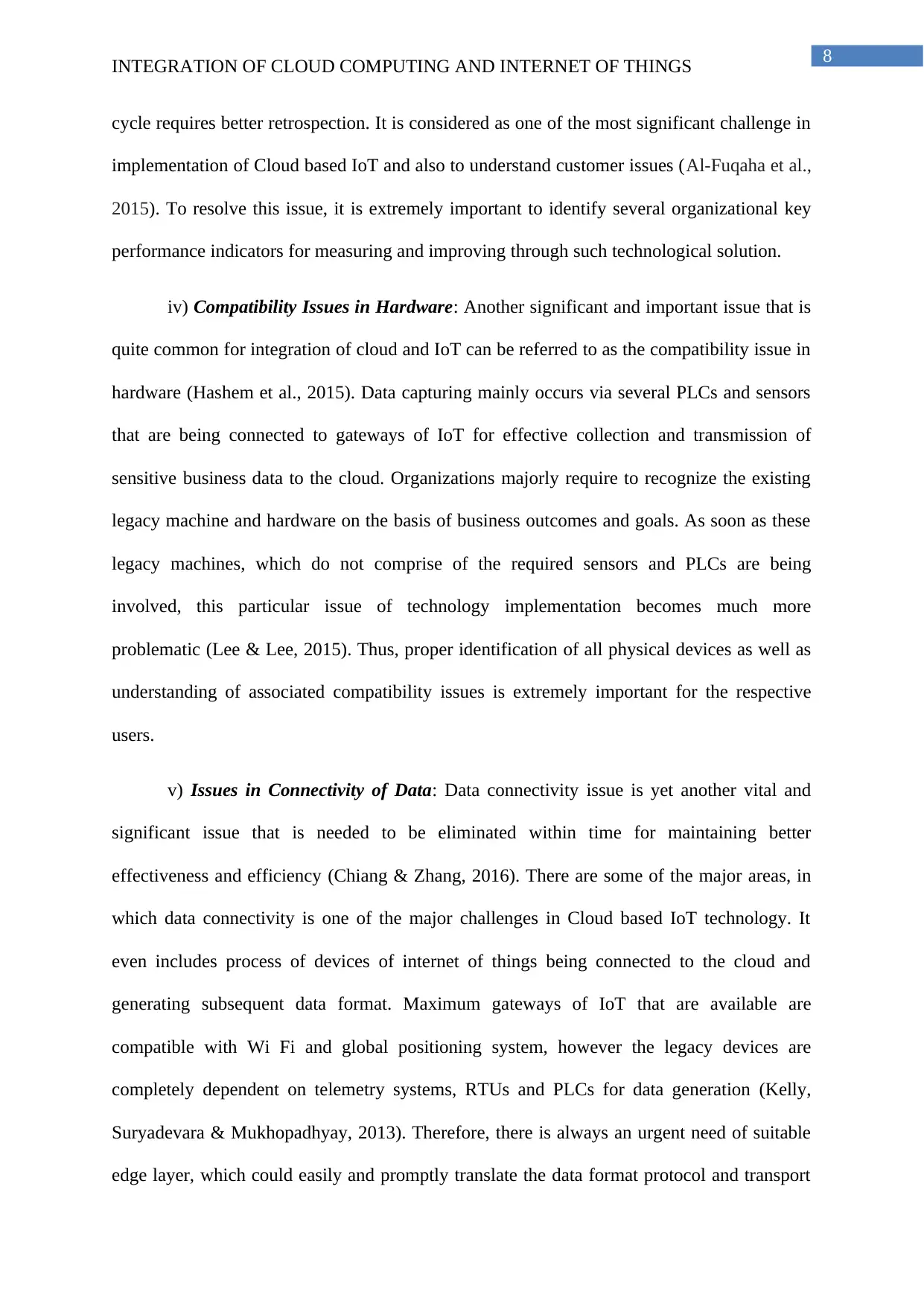
8
INTEGRATION OF CLOUD COMPUTING AND INTERNET OF THINGS
cycle requires better retrospection. It is considered as one of the most significant challenge in
implementation of Cloud based IoT and also to understand customer issues (Al-Fuqaha et al.,
2015). To resolve this issue, it is extremely important to identify several organizational key
performance indicators for measuring and improving through such technological solution.
iv) Compatibility Issues in Hardware: Another significant and important issue that is
quite common for integration of cloud and IoT can be referred to as the compatibility issue in
hardware (Hashem et al., 2015). Data capturing mainly occurs via several PLCs and sensors
that are being connected to gateways of IoT for effective collection and transmission of
sensitive business data to the cloud. Organizations majorly require to recognize the existing
legacy machine and hardware on the basis of business outcomes and goals. As soon as these
legacy machines, which do not comprise of the required sensors and PLCs are being
involved, this particular issue of technology implementation becomes much more
problematic (Lee & Lee, 2015). Thus, proper identification of all physical devices as well as
understanding of associated compatibility issues is extremely important for the respective
users.
v) Issues in Connectivity of Data: Data connectivity issue is yet another vital and
significant issue that is needed to be eliminated within time for maintaining better
effectiveness and efficiency (Chiang & Zhang, 2016). There are some of the major areas, in
which data connectivity is one of the major challenges in Cloud based IoT technology. It
even includes process of devices of internet of things being connected to the cloud and
generating subsequent data format. Maximum gateways of IoT that are available are
compatible with Wi Fi and global positioning system, however the legacy devices are
completely dependent on telemetry systems, RTUs and PLCs for data generation (Kelly,
Suryadevara & Mukhopadhyay, 2013). Therefore, there is always an urgent need of suitable
edge layer, which could easily and promptly translate the data format protocol and transport
INTEGRATION OF CLOUD COMPUTING AND INTERNET OF THINGS
cycle requires better retrospection. It is considered as one of the most significant challenge in
implementation of Cloud based IoT and also to understand customer issues (Al-Fuqaha et al.,
2015). To resolve this issue, it is extremely important to identify several organizational key
performance indicators for measuring and improving through such technological solution.
iv) Compatibility Issues in Hardware: Another significant and important issue that is
quite common for integration of cloud and IoT can be referred to as the compatibility issue in
hardware (Hashem et al., 2015). Data capturing mainly occurs via several PLCs and sensors
that are being connected to gateways of IoT for effective collection and transmission of
sensitive business data to the cloud. Organizations majorly require to recognize the existing
legacy machine and hardware on the basis of business outcomes and goals. As soon as these
legacy machines, which do not comprise of the required sensors and PLCs are being
involved, this particular issue of technology implementation becomes much more
problematic (Lee & Lee, 2015). Thus, proper identification of all physical devices as well as
understanding of associated compatibility issues is extremely important for the respective
users.
v) Issues in Connectivity of Data: Data connectivity issue is yet another vital and
significant issue that is needed to be eliminated within time for maintaining better
effectiveness and efficiency (Chiang & Zhang, 2016). There are some of the major areas, in
which data connectivity is one of the major challenges in Cloud based IoT technology. It
even includes process of devices of internet of things being connected to the cloud and
generating subsequent data format. Maximum gateways of IoT that are available are
compatible with Wi Fi and global positioning system, however the legacy devices are
completely dependent on telemetry systems, RTUs and PLCs for data generation (Kelly,
Suryadevara & Mukhopadhyay, 2013). Therefore, there is always an urgent need of suitable
edge layer, which could easily and promptly translate the data format protocol and transport
⊘ This is a preview!⊘
Do you want full access?
Subscribe today to unlock all pages.

Trusted by 1+ million students worldwide
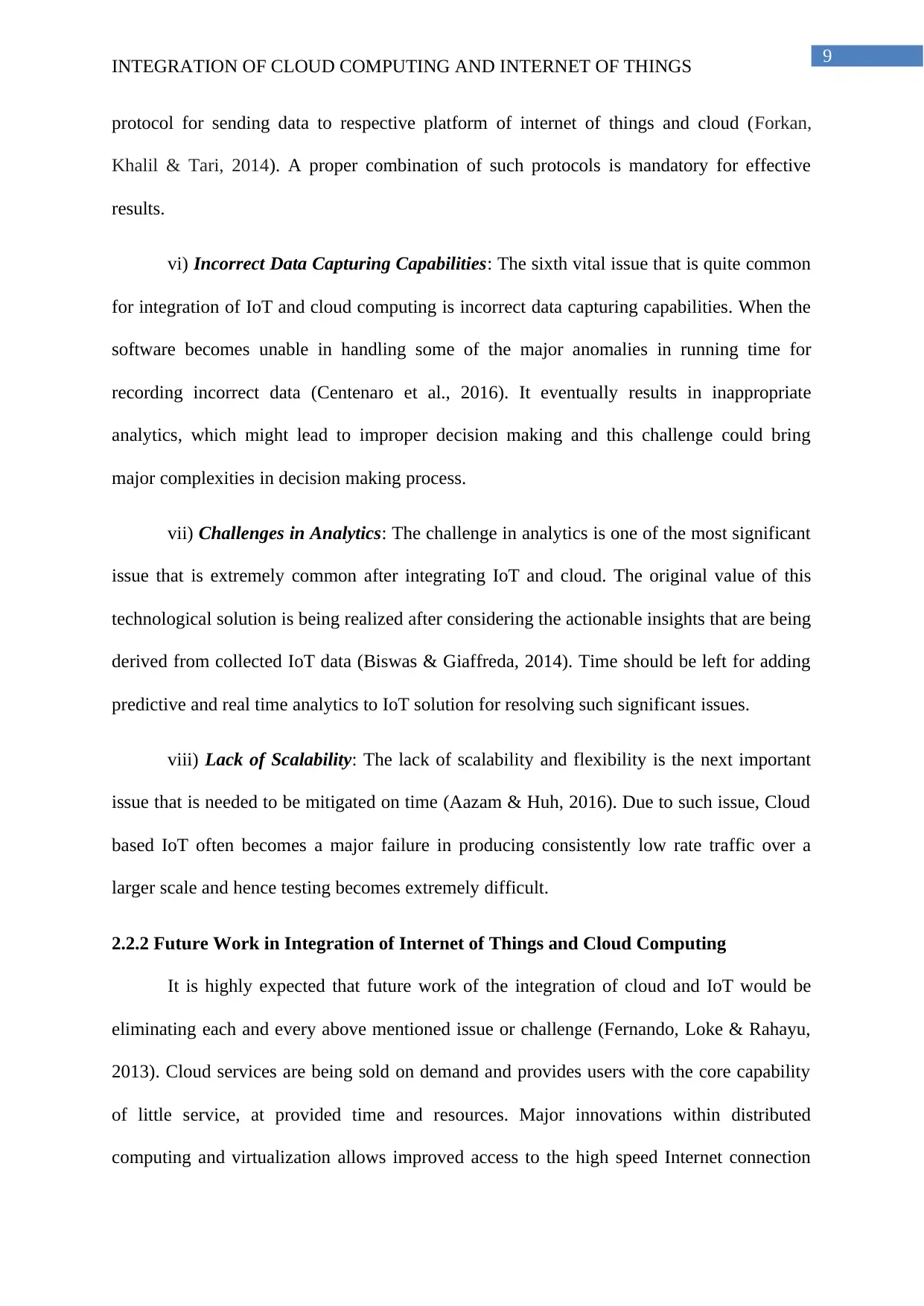
9
INTEGRATION OF CLOUD COMPUTING AND INTERNET OF THINGS
protocol for sending data to respective platform of internet of things and cloud (Forkan,
Khalil & Tari, 2014). A proper combination of such protocols is mandatory for effective
results.
vi) Incorrect Data Capturing Capabilities: The sixth vital issue that is quite common
for integration of IoT and cloud computing is incorrect data capturing capabilities. When the
software becomes unable in handling some of the major anomalies in running time for
recording incorrect data (Centenaro et al., 2016). It eventually results in inappropriate
analytics, which might lead to improper decision making and this challenge could bring
major complexities in decision making process.
vii) Challenges in Analytics: The challenge in analytics is one of the most significant
issue that is extremely common after integrating IoT and cloud. The original value of this
technological solution is being realized after considering the actionable insights that are being
derived from collected IoT data (Biswas & Giaffreda, 2014). Time should be left for adding
predictive and real time analytics to IoT solution for resolving such significant issues.
viii) Lack of Scalability: The lack of scalability and flexibility is the next important
issue that is needed to be mitigated on time (Aazam & Huh, 2016). Due to such issue, Cloud
based IoT often becomes a major failure in producing consistently low rate traffic over a
larger scale and hence testing becomes extremely difficult.
2.2.2 Future Work in Integration of Internet of Things and Cloud Computing
It is highly expected that future work of the integration of cloud and IoT would be
eliminating each and every above mentioned issue or challenge (Fernando, Loke & Rahayu,
2013). Cloud services are being sold on demand and provides users with the core capability
of little service, at provided time and resources. Major innovations within distributed
computing and virtualization allows improved access to the high speed Internet connection
INTEGRATION OF CLOUD COMPUTING AND INTERNET OF THINGS
protocol for sending data to respective platform of internet of things and cloud (Forkan,
Khalil & Tari, 2014). A proper combination of such protocols is mandatory for effective
results.
vi) Incorrect Data Capturing Capabilities: The sixth vital issue that is quite common
for integration of IoT and cloud computing is incorrect data capturing capabilities. When the
software becomes unable in handling some of the major anomalies in running time for
recording incorrect data (Centenaro et al., 2016). It eventually results in inappropriate
analytics, which might lead to improper decision making and this challenge could bring
major complexities in decision making process.
vii) Challenges in Analytics: The challenge in analytics is one of the most significant
issue that is extremely common after integrating IoT and cloud. The original value of this
technological solution is being realized after considering the actionable insights that are being
derived from collected IoT data (Biswas & Giaffreda, 2014). Time should be left for adding
predictive and real time analytics to IoT solution for resolving such significant issues.
viii) Lack of Scalability: The lack of scalability and flexibility is the next important
issue that is needed to be mitigated on time (Aazam & Huh, 2016). Due to such issue, Cloud
based IoT often becomes a major failure in producing consistently low rate traffic over a
larger scale and hence testing becomes extremely difficult.
2.2.2 Future Work in Integration of Internet of Things and Cloud Computing
It is highly expected that future work of the integration of cloud and IoT would be
eliminating each and every above mentioned issue or challenge (Fernando, Loke & Rahayu,
2013). Cloud services are being sold on demand and provides users with the core capability
of little service, at provided time and resources. Major innovations within distributed
computing and virtualization allows improved access to the high speed Internet connection
Paraphrase This Document
Need a fresh take? Get an instant paraphrase of this document with our AI Paraphraser
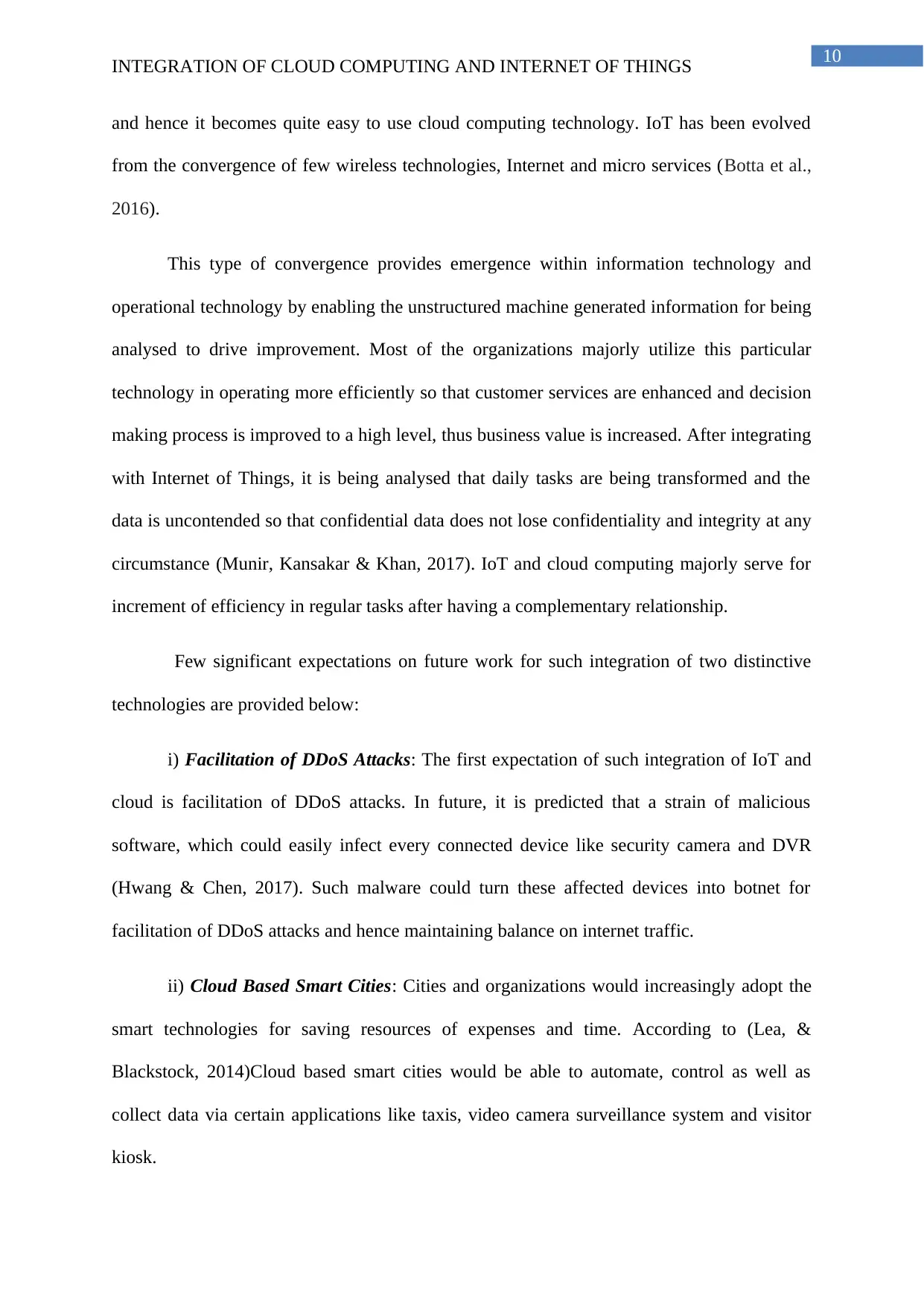
10
INTEGRATION OF CLOUD COMPUTING AND INTERNET OF THINGS
and hence it becomes quite easy to use cloud computing technology. IoT has been evolved
from the convergence of few wireless technologies, Internet and micro services (Botta et al.,
2016).
This type of convergence provides emergence within information technology and
operational technology by enabling the unstructured machine generated information for being
analysed to drive improvement. Most of the organizations majorly utilize this particular
technology in operating more efficiently so that customer services are enhanced and decision
making process is improved to a high level, thus business value is increased. After integrating
with Internet of Things, it is being analysed that daily tasks are being transformed and the
data is uncontended so that confidential data does not lose confidentiality and integrity at any
circumstance (Munir, Kansakar & Khan, 2017). IoT and cloud computing majorly serve for
increment of efficiency in regular tasks after having a complementary relationship.
Few significant expectations on future work for such integration of two distinctive
technologies are provided below:
i) Facilitation of DDoS Attacks: The first expectation of such integration of IoT and
cloud is facilitation of DDoS attacks. In future, it is predicted that a strain of malicious
software, which could easily infect every connected device like security camera and DVR
(Hwang & Chen, 2017). Such malware could turn these affected devices into botnet for
facilitation of DDoS attacks and hence maintaining balance on internet traffic.
ii) Cloud Based Smart Cities: Cities and organizations would increasingly adopt the
smart technologies for saving resources of expenses and time. According to (Lea, &
Blackstock, 2014)Cloud based smart cities would be able to automate, control as well as
collect data via certain applications like taxis, video camera surveillance system and visitor
kiosk.
INTEGRATION OF CLOUD COMPUTING AND INTERNET OF THINGS
and hence it becomes quite easy to use cloud computing technology. IoT has been evolved
from the convergence of few wireless technologies, Internet and micro services (Botta et al.,
2016).
This type of convergence provides emergence within information technology and
operational technology by enabling the unstructured machine generated information for being
analysed to drive improvement. Most of the organizations majorly utilize this particular
technology in operating more efficiently so that customer services are enhanced and decision
making process is improved to a high level, thus business value is increased. After integrating
with Internet of Things, it is being analysed that daily tasks are being transformed and the
data is uncontended so that confidential data does not lose confidentiality and integrity at any
circumstance (Munir, Kansakar & Khan, 2017). IoT and cloud computing majorly serve for
increment of efficiency in regular tasks after having a complementary relationship.
Few significant expectations on future work for such integration of two distinctive
technologies are provided below:
i) Facilitation of DDoS Attacks: The first expectation of such integration of IoT and
cloud is facilitation of DDoS attacks. In future, it is predicted that a strain of malicious
software, which could easily infect every connected device like security camera and DVR
(Hwang & Chen, 2017). Such malware could turn these affected devices into botnet for
facilitation of DDoS attacks and hence maintaining balance on internet traffic.
ii) Cloud Based Smart Cities: Cities and organizations would increasingly adopt the
smart technologies for saving resources of expenses and time. According to (Lea, &
Blackstock, 2014)Cloud based smart cities would be able to automate, control as well as
collect data via certain applications like taxis, video camera surveillance system and visitor
kiosk.
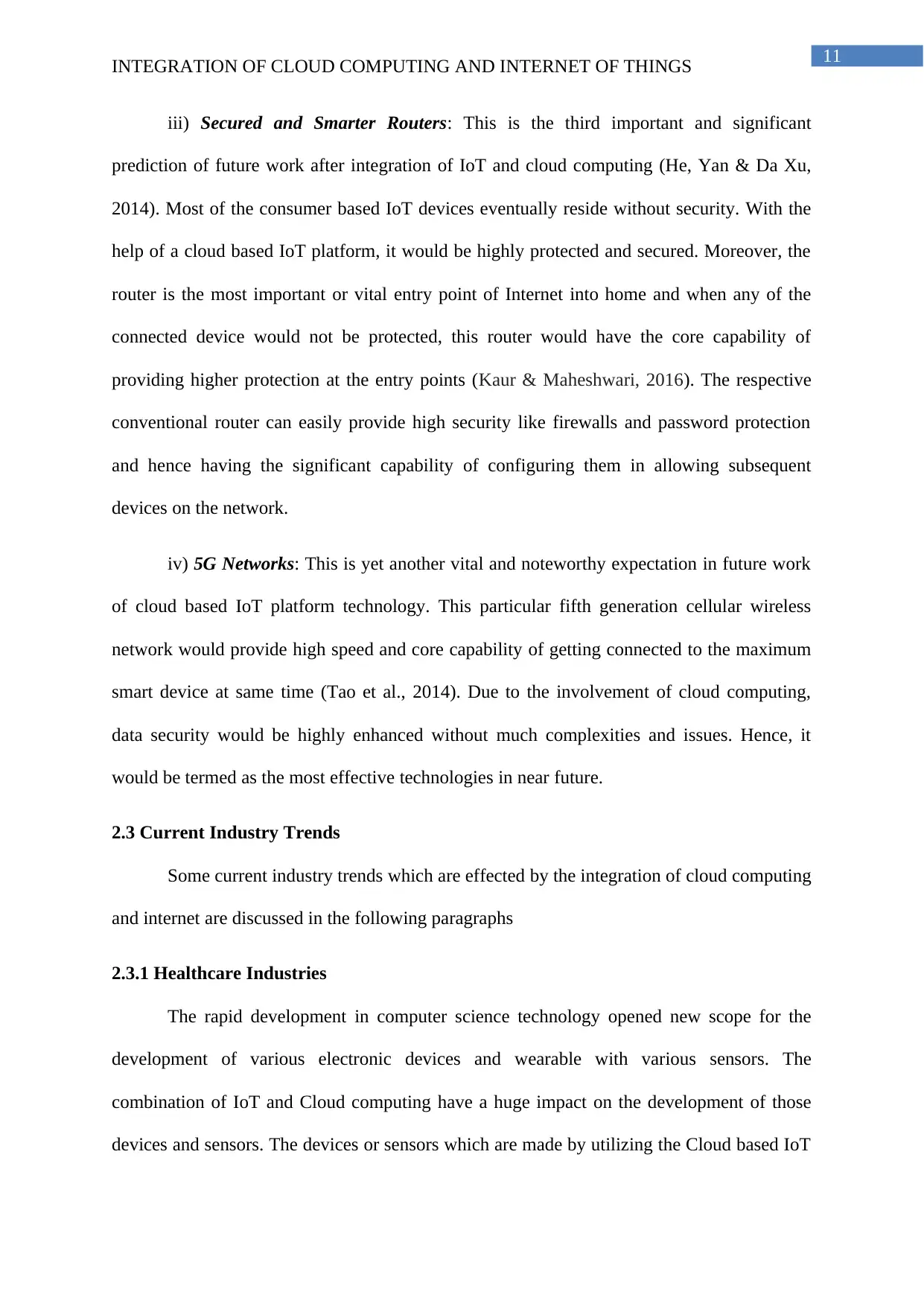
11
INTEGRATION OF CLOUD COMPUTING AND INTERNET OF THINGS
iii) Secured and Smarter Routers: This is the third important and significant
prediction of future work after integration of IoT and cloud computing (He, Yan & Da Xu,
2014). Most of the consumer based IoT devices eventually reside without security. With the
help of a cloud based IoT platform, it would be highly protected and secured. Moreover, the
router is the most important or vital entry point of Internet into home and when any of the
connected device would not be protected, this router would have the core capability of
providing higher protection at the entry points (Kaur & Maheshwari, 2016). The respective
conventional router can easily provide high security like firewalls and password protection
and hence having the significant capability of configuring them in allowing subsequent
devices on the network.
iv) 5G Networks: This is yet another vital and noteworthy expectation in future work
of cloud based IoT platform technology. This particular fifth generation cellular wireless
network would provide high speed and core capability of getting connected to the maximum
smart device at same time (Tao et al., 2014). Due to the involvement of cloud computing,
data security would be highly enhanced without much complexities and issues. Hence, it
would be termed as the most effective technologies in near future.
2.3 Current Industry Trends
Some current industry trends which are effected by the integration of cloud computing
and internet are discussed in the following paragraphs
2.3.1 Healthcare Industries
The rapid development in computer science technology opened new scope for the
development of various electronic devices and wearable with various sensors. The
combination of IoT and Cloud computing have a huge impact on the development of those
devices and sensors. The devices or sensors which are made by utilizing the Cloud based IoT
INTEGRATION OF CLOUD COMPUTING AND INTERNET OF THINGS
iii) Secured and Smarter Routers: This is the third important and significant
prediction of future work after integration of IoT and cloud computing (He, Yan & Da Xu,
2014). Most of the consumer based IoT devices eventually reside without security. With the
help of a cloud based IoT platform, it would be highly protected and secured. Moreover, the
router is the most important or vital entry point of Internet into home and when any of the
connected device would not be protected, this router would have the core capability of
providing higher protection at the entry points (Kaur & Maheshwari, 2016). The respective
conventional router can easily provide high security like firewalls and password protection
and hence having the significant capability of configuring them in allowing subsequent
devices on the network.
iv) 5G Networks: This is yet another vital and noteworthy expectation in future work
of cloud based IoT platform technology. This particular fifth generation cellular wireless
network would provide high speed and core capability of getting connected to the maximum
smart device at same time (Tao et al., 2014). Due to the involvement of cloud computing,
data security would be highly enhanced without much complexities and issues. Hence, it
would be termed as the most effective technologies in near future.
2.3 Current Industry Trends
Some current industry trends which are effected by the integration of cloud computing
and internet are discussed in the following paragraphs
2.3.1 Healthcare Industries
The rapid development in computer science technology opened new scope for the
development of various electronic devices and wearable with various sensors. The
combination of IoT and Cloud computing have a huge impact on the development of those
devices and sensors. The devices or sensors which are made by utilizing the Cloud based IoT
⊘ This is a preview!⊘
Do you want full access?
Subscribe today to unlock all pages.

Trusted by 1+ million students worldwide
1 out of 21
Related Documents
Your All-in-One AI-Powered Toolkit for Academic Success.
+13062052269
info@desklib.com
Available 24*7 on WhatsApp / Email
![[object Object]](/_next/static/media/star-bottom.7253800d.svg)
Unlock your academic potential
Copyright © 2020–2025 A2Z Services. All Rights Reserved. Developed and managed by ZUCOL.





